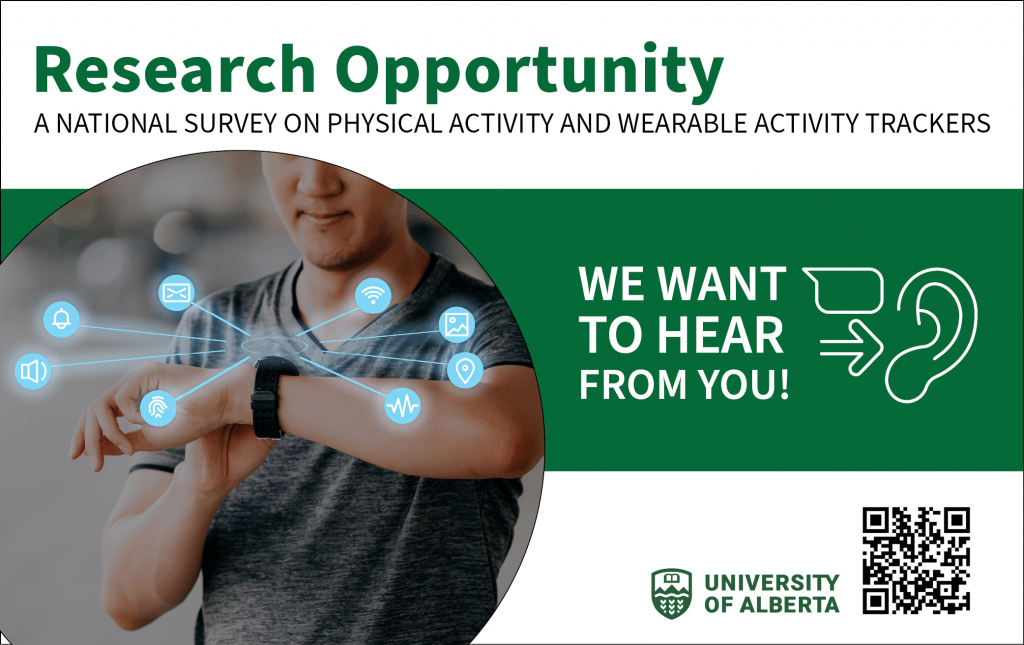Researchers from the University of Alberta are looking for participants nation-wide, ages 18 – 35, to participate in a study that looks at the correlation between wearing physical activity trackers and physical activity.
The purpose of this survey is to get feedback directly from young adults between the ages of 18 and 35 to learn about your experiences and preferences related to participating in physical activity. We are interested in hearing your thoughts on whether the use of a wearable activity tracker could be helpful to improving physical activity in your life.
The survey asks for minimal personal information and will take about 15-20 minutes to complete. More information, including instructions, can be found by visiting the survey link in the button below.
A little bit of background
Physical inactivity is an increasing health concern for the autistic community. A growing body of research suggests that autistic people of all age groups are less physically fit (Borremans et al., 2010), less physically active (Jones et al., 2017), and engage in fewer sports/recreational activities as compared to their allistic peers (Brewster & Coleyshaw, 2011).
Guidelines from the Canadian Society for Exercise Physiology (CSEP, 2011) and Public Health Agency of Canada (as reported in Tremblay et al., 2011) recommend that young adults engage in a weekly minimum of 150 minutes of moderate to vigorous physical activity (MVPA) to improve health and reduce susceptibility to disease and illness. However, many studies (e.g., Eaves & Ho, 2008; Lang et al., 2010; Pan & Frey, 2006) report that large portions of the autistic population are more likely to engage in sedentary behaviours for significant amounts (i.e., an average of 13 hours) of the day.
In short, a sedentary lifestyle is associated with obesity and other physical and mental health related conditions. Only a few lifestyle choices have as large an impact on your health as physical activity. Participating in regular physical activity is one of the most important things you can do for your health. It is vital for healthy aging, can reduce the burden of chronic diseases and prevent early death. Young adults who sit less and participate in any amount of mild, moderate, or strenuous physical activity will gain health benefits, including improved balance, mobility, fitness, and better mental health.
Why should you participate?
Your participation contributes towards improving our limited knowledge of physical health trends among young adults through direct feedback from young adults. The information collected in this survey will help us to understand what factors encourage physical activity and motivate the use of activity trackers for young adults.
It can be incredibly fulfilling to know that your participation will help benefit other young adults in the future, through increasing our understanding of what motivators/barriers may influence decisions to participate in physical activity or use activity trackers.
What is Physical Activity?
Physical activity is any form of body movement that uses energy. It includes many different types of daily activities such as completing chores, daily movement, sports, and recreation. Participation in physical activity can happen in a variety of environments (e.g., home/work/community; indoors/outdoors) and contexts (e.g., leisure, transportation, occupation, household) across all seasons.
Guidelines on Physical Activity
Health Canada recommends that adults participate in a minimum of 2.5 hours (150 minutes) of physical activity weekly to attain optimal health benefits.
Through this study, researchers are interested in understanding young adults perspectives on the intensity of physical activity they participate in based on three categories:
Mild Activity
This activity needs very little effort and does not cause you to sweat. Examples include: casual walking, light stretching, or yoga.
Moderate Activity
This activity needs some effort and you may breathe harder or increase your heart rate. However, it is not exhausting and you should be able to talk while doing the activity. Examples include: jogging, dancing, or light yard work.
Strenuous Activity
This activity is intense and requires a lot of energy. It will cause you to breathe hard/fast and your heart rate is increased. You may be unable to say more than a few words without stopping to catch your breath. Examples include: running, interval training, or heavy yard work such as landscaping.
Wearable Activity Trackers
Wearable activity trackers are electronic monitoring devices that allow users to access and monitor health-related information specific to physical activity including: daily steps taken, calories burned, distance traveled, heart rate, and sleep patterns. The primary reason people invest in an activity tracker is to help motivate them to get, or stay, active. Previous research has found that wearable activity trackers can be useful in reminding you to get up and move around when you have been still for too long, or helping you to have more control over your personal health by providing direct access to information.
How do I participate?
If you are between the ages of 18 and 35 and would like more information about this study and to participate, visit their website activehealthproject.com or click the button below that says, Take me to the Active Health Project
Take me to the Active Health Project
This research is conducted through the University of Alberta. Ethics ID: Pro00118119.
Principal investigator: Michael Barrett (mcbarret@ualberta.ca)


